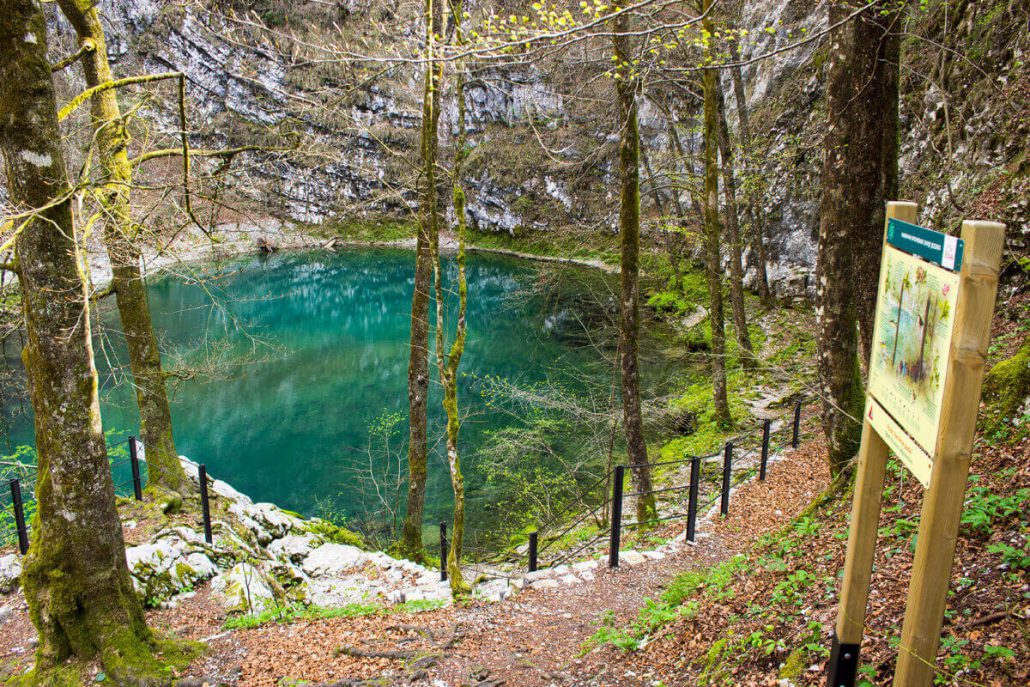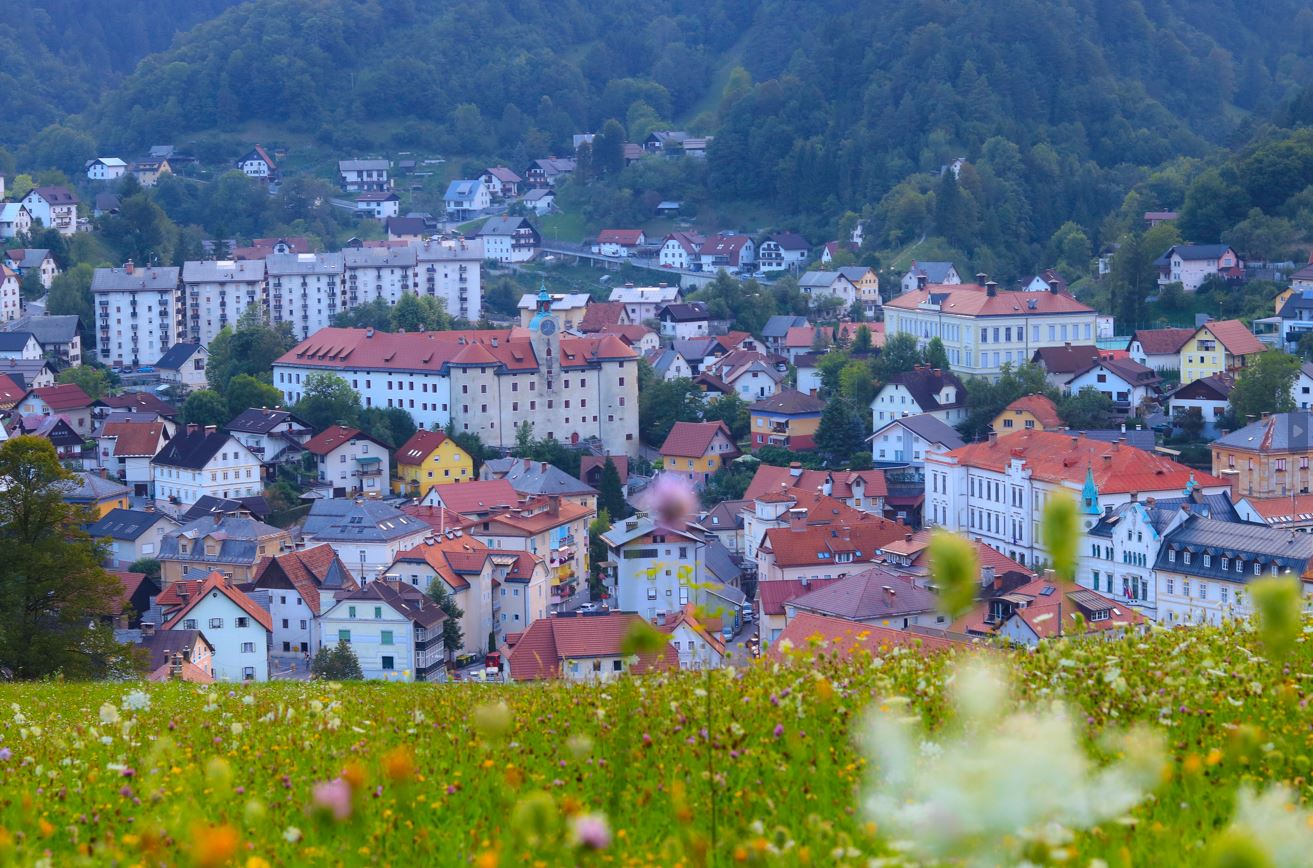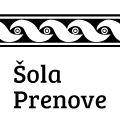From miners to lacemakers, from culture to nature
A walk through Idrija is a stroll through more than half a millennium of mining, which importantly marked life in the town and beyond. Explore its sights. Get down to the underworld too!
First meeting with Idrija
Start the circular route at the Idrija Geopark Visitor Centre (1), which is in the very centre of the town. The exhibition Written in Rocks, which can also be viewed virtually, will open your eyes to all the special features that await you on the recommended route.
A Tip: The building which houses the Visitor Centre was once Nebesa inn, known far and wide for the famous Idrija žlikrofi (2) , the first Slovenian dish with European protection of traditional specialties. Taste them in one of Idrija’s inns.
(Recommended time for a stop: 45 minutes. You need 2 minutes to reach the next point.)
The luxury of the past
From the entrance to the Visitor Centre (1), a mighty castle catches the eye. The path along the Nikova stream takes you to its yard.
The Renaissance Gewerkenegg castle (3) was never the home of the aristocracy. It had mercury warehouses and the mine’s administration. It now presents the collections of the Idrija Municipal Museum (4), which tell about the town’s past, the mine and the globally important technical heritage.
There is also the History Written in Thread exhibition, which presents more than 300 years of bobbin lace making in the Idrija region. In the castle courtyard, where you can observe elements of the Baroque restoration of the castle, arcades and frescoes, there is also a studio in which Idrija lace is created (5).
(Recommended time for a visit: 10 minutes, 60-90 minutes to visit the museum. You need 5 minutes to reach the next point.)
From the castle to the mine
On the other side of the castle courtyard, go down the steps to the bridge with the nearby chapel of John of Nepomuk (6).
Go along Kosovelova ulica street to Scopoli’s house (7) with a fountain and a statue of a miner.
You will soon see Šelštev (8) in front of you – a mighty white building from the 18th century. It houses a restored mine register office and an interactive display of Idrija’s geological heritage.
Underground excitement
In the Šelštev building (8) there is the entrance to the Anthony’s Shaft (9), the oldest part of the Idrija mine and the second oldest preserved mine entrance in Europe. It was excavated as early as 1500. For 500 years, miners descended here into the second largest mercury mine in the world. Accompanied by a guide and in the light of cave lamps, descend to the underground chapel and valuable ore. With a little luck you will be surprised by the mine dwarf Perkmandlc.
(Recommended time for a stop: 10 minutes, 90 minutes to see the Anthon’s Shaft. You need 1 min to reach the next point.)
A square of mining life
After visiting Šelštev and the Anthony’s Shaft, head over the small bridge to Trg Sv. Ahacija square with a Baroque fountain (10) associated with the site of a rich vein of mercury ore. The oldest brick theatre building once housed the Mine Theatre (11). Today, it is both the theatre and the cinema. The Teresian monumental building, which now houses a gallery and a library (12) is also interesting. Until 1912, there was a mining warehouse here. On the façade, there are plaques dedicated to the people who marked the development of Idrija. From Trg svetega Ahacija square, take the arched underpass to Mestni trg square, which is adorned by the Art Nouveau Town Hall (13) from 1898.
(You need 20 minutes to reach the next point. )
Between mining residential buildings
From Mestni trg square, cross the park towards Lapajnetova ulica street and head to the pedestrian bridge over the Idrijca River (14). Continue past the Church of St. Joseph the Worker (15) to prhavzi (16) on Arkova ulica street. Prhavzi are typical multi-apartment houses for workers, which the mine built at the turn of the 19th and 20th centuries for its employees. You can also see more typical mining houses in Rudarska ulica street, as the mine employed more than a thousand people at that time.
(To reach the next point you need 3 minutes.)
Burning of unusual metal
When you turn from Rudarska ulica street into Arkova ulica street, you will reach the Hg Smelting Plant (17). Here you will learn about the true character of mercury, which is the only metal that is liquid at room temperature. After an interactive presentation of cinnabar ore burning techniques, you will understand how in Idrija almost 150,000 tons of this liquid metal have been obtained in the 500 years of the mine’s operation. This is as much as 13 percent of all mercury extracted in the world. If we wanted to put it in a single place, we would need the Pyramid of Cheops for it.
(Recommended time for a stop: 10 minutes, 60 – 90 minutes to see the exhibitions. You will need 10 minutes to reach the next point.)
A visit to the mine house
On your way back after crossing the Idrijca River, turn onto Rožna ulica street and then continue along Bazoviška ulica street to Francis’s Shaft (18). You can see mining machinery at the Idrija Municipal Museum by prior arrangement. Among them is also one of the largest preserved steam engines in Europe.
In the immediate vicinity is a characteristic Mine House (19). The steep roof gives it away. By prior arrangement, you can visit the home of a mining family with authentic furniture and talk to a miner’s wife, who will also show you the secrets of lacemaking.
(Recommended time for a stop: 5 minutes, a guided tour – 45 minutes. 2 minutes to the next point.)
The site of Škafar's legend
Before returning to the starting point, stop at the Holy Trinity Church (20), built in 1500. The oldest church in Idrija is built on the site of a legend about the discovery of mercury in Idrija. In 1490, a farmer called Škafar is said to have noticed an unusual gleam when pouring water into a tub. The tub, filled with native mercury instead of water, was so heavy that he could not lift it.
Nearby is the Municipal Apiary (21), built as early as 1925 by order of Franc Lapajne, a well-known Idrija lace merchant. It is decorated with beehive panels, painted with motifs of Idrija and Idrija heritage.
A Tip: Among the delicacies that boast the Idrija Selected Certificate is also honey. Honey and other culinary and handicraft products having the Idrija Selected certificate are available at the Visitor Centre (1), where you can also arrange for a tasting of typical culinary specialties.
(Recommended time for a stop: 10 minutes. 2 minutes to the next point.)
Back to Mestni trg square
Return to Mestni trg squre and see the monumental building of Idrija Lace School (22), opened in 1876. You can learn about lace making (5) in many shops and studios.
A Tip: Plan to return to the town during the Idrija Lace Festival. www.festivalidrijskecipke.si
Suggestion for a hike
To Wild lake
From the centre of Idrija, it is only 3 kilometres to an unusual lake nestled between a hundred meters of precipice walls.
On the way to the lake, you will be surprised by the Idrija kamšt – a large water-powered pumping device from 1790. Its drive wheel is more than 13 meters in diameter. It used to pump cave water from a mine. Turn onto the natural science educational path, which will take you to the mysterious Wild Lake, the first Slovenian museum in nature, along rake water canals. Water flows into the lake from a steeply descending tunnel, which has so far been explored to a depth of 160 meters.
More information: Idrija TIC

1. Idrija Geopark Visitor Centre
The centre is an excellent starting point for exploring Idrija. You can see the “Written in Rocks” exhibition, which is on display at the Visitor Centre, on your own, with an audio guide, the TeachOUT app or with interpreter guides who will take you on an interesting, interactive journey into the geological past. You will get to know the story of Idrija’s origin and be acquainted with our cultural and natural sights with help of scale models, exhibits, animations and video presentations. The exhibition is an excellent starting point to decide where to go in nature and what to see. By prior arrangement, the Centre will also prepare a tasting of local delicacies.
Prelovčeva 5, T: 05 37 43 916
2. Idrija žlikrofi
Idrija žlikrofi is a famous Idrija dish with the national and European label of Guaranteed traditional specialty. It is a specially designed dish made of noodle dough filled with stuffing of boiled potatoes, onions, cracklings or minced meat and marjoram. A text kept at the Municipal Museum says that “women of Idrija put in them all their culinary knowledge, love and longing.” The traditional Idrija žlikrofi are offered in most inns, as well as in local stores and on the market.
3. Gewerkenegg castle
The castle was built in the early 16th century – soon after the discovery of a rich deposit of mercury. The owners of the mine built it to defend against the Venetians and the Turks, to store mercury and food, and to house the mine management. At the beginning of the 17th century, the castle became the administrative centre of the newly established Idrija estate. In the last quarter of the 17th century, the old wooden foundations were replaced with new, built ones, and at the same time, an apartment for mine employees and warehouses were arranged. Here, they kept a two-year supply of grain for all mine workers. The castle underwent Baroque renovation in the 18th century. The courtyard was made more appealing with arcades and Baroque paintings.
Prelovčeva 9, T: 05 37 266 00
4. Idrija Municipal Museum
The museum presents the town’s heritage at Gewerkenegg Castle, in the Idrija Kamšt, the Idrija Mine House and in the technical department of the museum in the Francis’s Shaft. The exhibitions at the castle tell the half-millennium-long story of Idrija and the technical achievements associated with mining, the connection with the Spanish Almadén, where the largest mercury mine in the world operated, and the sophistication of Idrija lace.
Prelovčeva 9, T: 05 37 266 00
5. Idrija lace
Idrija has always been considered an important centre of lacemaking knowledge, from where the skill of designing and making lace artwork spread to the wider world. Idrija lace was first mentioned in 1696. Along with traditional knowledge, new approaches and innovative products are being developed in the town today. They include lace in modern trends in fashion and arts and crafts. The famous Lace School operates in the town, and the Idrija Lacemakers’ Association takes care of the preservation of the heritage. The geographical indication “Idrija lace” guarantees quality of Idrija bobbin lace from a specific area. The universal value of the Idrija bobbin lace art was recognized by the joint entry of “Lacemaking in Slovenia” on UNESCO’s Representative List of Intangible Cultural Heritage.
6. Chapel of St. John of Nepomuk
A chapel, dedicated to St. John of Nepomuk, is located at the foot of the castle, by the Nikova stream. It was built in memory of a large flood in 1525, which was the result of a landslide, caused by a strong earthquake in 1511. It acquired its present square floor plan and a small tower during the Baroque period.
Kosovelova ulica
7. Scopoli's house
The history of the house, named after the famous naturalist Antonius Scopoli, the first doctor in Idrija, dates back to the 18th century. At first, the house was owned by the mine manager F. A. Steinberg, but later it was used as a doctor’s office and the residence of mine doctors. Among them was also Scopoli, who worked in Idrija in the years 1754 – 1769. He cultivated various types of plants, which he brought from his research trips, and created the work Flora Carniolica (1760, 1772).
8. Šelštev
An imposing building from the mid-18th century served as a register office – a space where the miners registered for work at the entrance to the mine. On the first floor, an infirmary was opened in 1787, where they treated miners poisoned with mercury. At the end of the 19th century, housing for immigrant mine employees was arranged in the building. Since 1994, Šelštev has been used as the entrance to the tourist mine.
Kosovelova ulica 3
9. Anthony's shaft
The oldest part of the Idrija mine hides and reveals invaluable wealth under the town streets, which has been the driving force of the development of the mining town for 500 years. The shaft was excavated in 1500 and is the oldest preserved entrance to the mine in Europe. The 300-meter-long entry tunnel, which was initially supported with timber, and later reinforced with limestone blocks, houses the St. Barbara Chapel. A visit to Anthony’s Shaft is an unforgettable experience, also suitable for children.
Kosovelova 3, T: 05 37 71 142
10. Baroque fountain
The oldest square in Idrija boasts a Baroque fountain, which supposedly stands at the exact site of the discovery of mercury ore. At the location where rich cinnabar ore was discovered on St. Achatius Day (June 22, 1508), Achatius’s shaft or the ‘shaft of happiness ‘ was used for many decades. Later, a Baroque fountain was erected there. This was an important working site, but also a space, where people met and celebrated various events. Many important cultural premises and outbuildings grew there.
Trg sv. Ahacija
11. Idrija film theatre - Mine theatre
The Idrija Film Theatre operates in the oldest preserved theatre building in Slovenia. It was erected around 1770 from material left over from the construction of a nearby granary. The Baroque oval-shaped building with a Classicist lobby had 17 loges, and the hall seated up to 300 visitors. The program was created by local enthusiasts and traveling artists. In 1952, the building was adapted for cinematic viewing, and since 2001, it has been a monument of national importance.
Trg sv. Ahacija 5
12. Magazin Gallery and Town library– Mine magazin
In one of the oldest Baroque buildings in Slovenia, there was a granary for almost a decade and a half. From 1764 to 1912, Idrija miners received part of their wages in the form of grain and other foodstuffs. Today, the Mine warehouse (magazin) houses the Magazin Gallery, the Town Library and Reading Room and the Military Museum, which can be viewed by prior arrangement. The building has been a monument of national importance since 2001.
Ulica sv. Barbare 4-5
13. Town Hall
Idrija Town Hall is a representative Art Nouveau administrative palace, built in 1898. Today, it is the seat of the municipal administration. In celebration of the rich five-hundred-year old mining past, a dedication plaque to Idrija miners was mounted on the lobby wall in 1990, and the painter Nande Rupnik made graffiti based on a design by Ivan Seljak Čopič. In 1992, a meeting hall was decorated with graffiti: Nande Rupnik dedicated the decoration to the mine’s technical masterpieces, and the academic painter Rudi Skočir to all generations of Idrija miners.
Mestni trg 1
14. The Idrijca
In the Idrija region, the Idrijca River flows through the short and narrow gorge Strug with very steep slopes. During heavy rains, it is fed by numerous short tributaries and several karst springs. With help of the Kobila dam, its waters fill the famous Idrija rake – the canals through which water was once supplied to drive the mine pumps. This area is a protected Zgornja Idrijca Landscape Park. A little further, the river flows through the town of Idrija. Here, the Nikova stream joins it from the left.
15. The church of St. Joseph The Worker and The church of St. Barbara
The parish church, built in 1969, stands at the crossroads of Idrija traffic roads. It replaced the Church of St. Barbara, which was severely damaged at the end of World War II, and the cemetery Church of St. Cross, of which only the bell tower remained. St. Barbara is the patron saint of miners, while St. Joseph the Worker is the protector of artisans and craftsmen.
Arkova 1
16. Prhavzi - Rudarska street
The mine built barracks for the workers, so younger miners with lower wages could afford a healthy and cheap stay. The first prhavz – a 12-apartment workers’ block, which was partly made of wood, was built in 1872. In the following decades, 14 well-built larger apartment blocks and 10 smaller two-family workers’ houses were constructed. Around 1900, a third of the miners were already housed in these apartments.
17. Hg Smelting plant
Over five centuries, ore burning evolved from the simplest piles in the 16th century to sophisticated rotary kilns that operated until 1995. The Hg smelting plant comprises a cable car end station, separation, conveyor belt, collection hopper with feeder, rotary kiln and smoke chamber with flue. The complex has a modern visitor centre. With the help of experiments, animations, videos and devices that work on the basis of Hg, you can get to know and experience the importance of this unique liquid metal.
Arkova 50
18. Francis's shaft
The shaft from 1792 was used to transport miners and material to a depth of 272 meters. In the entrance building of the Francis’s shaft, mining machines and devices are on display, some of which are still in operation. Among them is the 1893 Kley pump, which was used for pumping cave water for fifty years and is, according to known data, the only preserved device of its kind in the world.
Bazoviška ulica 2
19. Mine house
The house was built in the late 18th and renovated in the 19th century. The building, which has a high gable, three floors, a ground floor and an attic, is mostly built of wood, only the ground floor is made of stone. It is surrounded by vegetable gardens. The house tells the story of the life of Idrija miners. To see the interior, make an appointment at the Municipal Museum.
Bazoviška ulica 4
20. Holy Trinity church
The oldest church in Idrija was built on the site where Škafar discovered mercury in 1490 according to the legend. The originally wooden church from 1500, was later masoned. The presbytery is decorated with colourful stained glass. Ore, a pointed mining tool and a carbide lamp appear there as eloquent symbols.
Študentovska ulica
21. Idrija Municipal Apiary
The apiary, which was ordered by Franc Lapajne, a large lace merchant, at the beginning of the 20th century, differs from conventional Slovenian apiaries. Its central part is extended and made of mesh windows. The Lapajne family used it for meetings and friendly gatherings.
Ulica IX. korpusa , T: 05 37 43 916
22. Idrija Lace School
After its construction in 1876, the former folk school was one of the largest school buildings in Slovenia. Now, the building is home to the International Centre of Idrija Lace and Lace School with a permanent exhibition of bobbin lace masterpieces. The school has been taking care of the transfer of knowledge, preservation and development of lacemaking skills for more than 140 years in a row.
Prelovčeva ulica 2, T: 05 37 34 570
- 11. Idrija Geopark Visitor Centre
- 22. Idrija žlikrofi
- 33. Gewerkenegg castle
- 44. Idrija Municipal Museum
- 55. Idrija lace
- 66. Chapel of St. John of Nepomuk
- 77. Scopoli's house
- 88. Šelštev
- 99. Anthony's shaft
- 1010. Baroque fountain
- 1111. Idrija film theatre - Mine theatre
- 1212. Magazin Gallery and Town library– Mine magazin
- 1313. Town Hall
- 1414. The Idrijca
- 1515. The church of St. Joseph The Worker and The church of St. Barbara
- 1616. Prhavzi - Rudarska street
- 1717. Hg Smelting plant
- 1818. Francis's shaft
- 1919. Mine house
- 2020. Holy Trinity church
- 2121. Idrija Municipal Apiary
- 2222. Idrija Lace School





